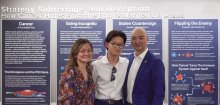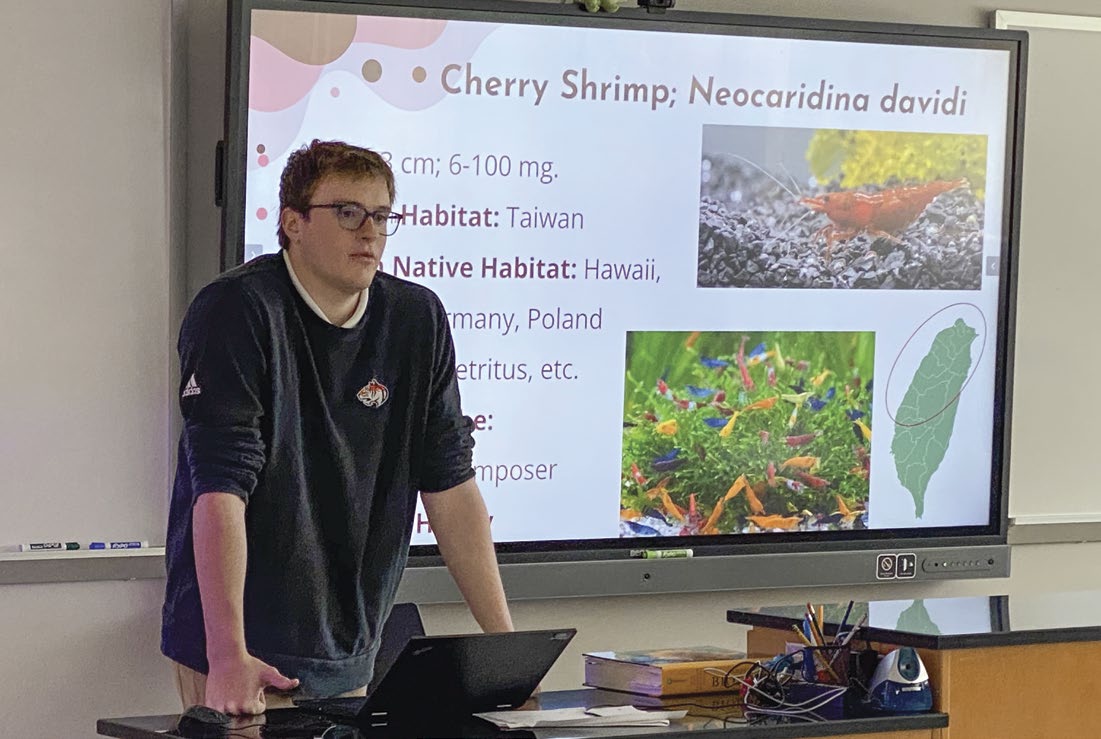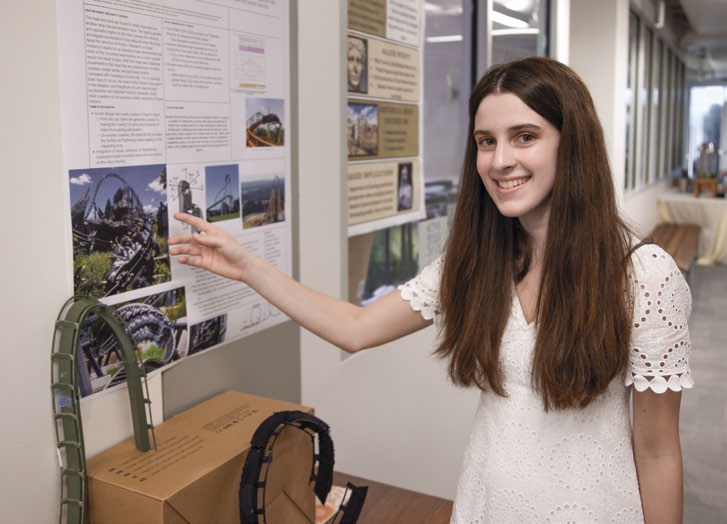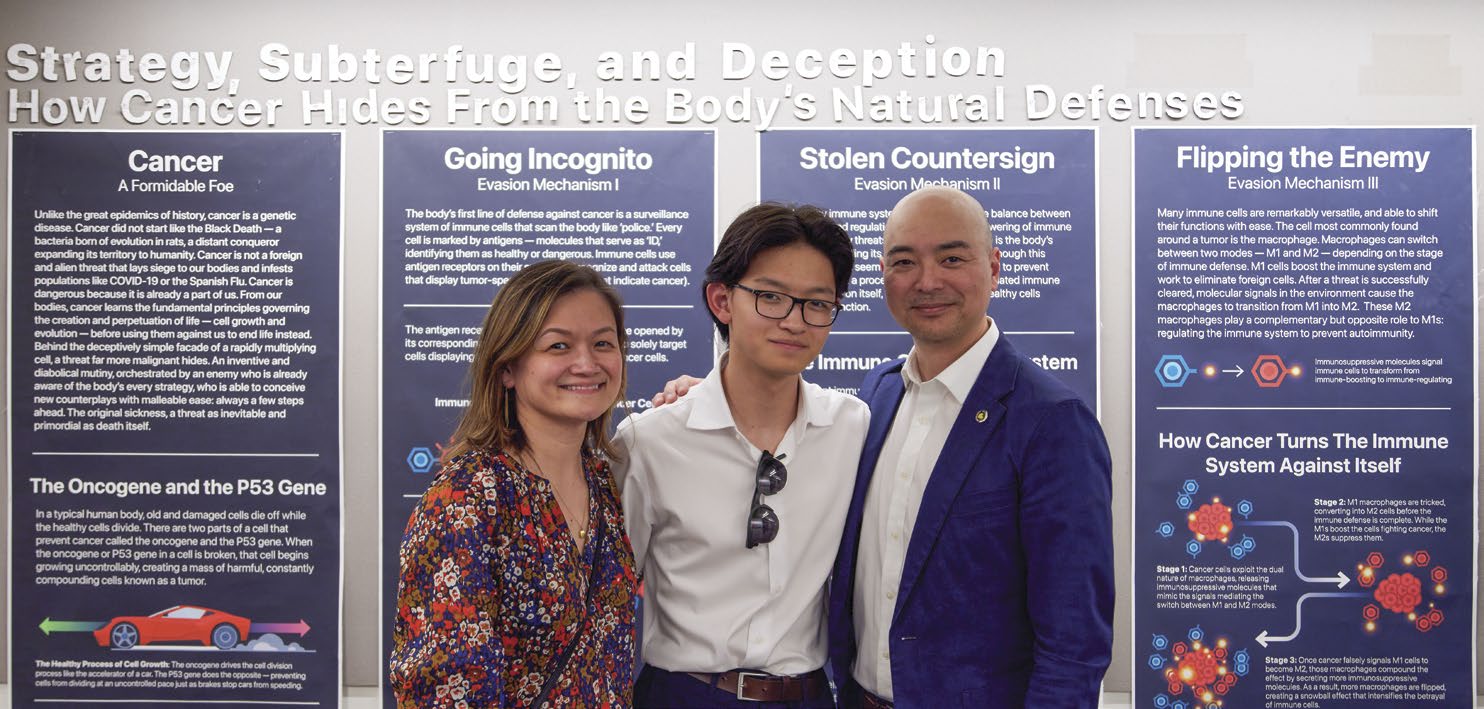
In this series, we highlight students as they are deeply engaged in the process of learning, taking responsibility for extending their knowledge and skills, and constructing opportunities for real-world application. In this issue, we highlight students, who through their Intersession, Junior Thesis, and Advanced Research Class are pursuing their interest in STEM-related fields.
KAI HARASHIMA ’25
Strategy, Subterfuge, and Deception How Cancer Evades the Body’s Natural Defenses
Kai Harashima’s large posters at Junior Thesis night looked like works of art, with eye-catching graphics of cells interacting with one another. However, the subject was hard science—brain cancer research. “I’m using art as a way to communicate complex scientific concepts that can be difficult to understand,” he said.
In addition to his typical course load, Kai spent his junior year working to understand brain cancer during the winter Intersession and as part of his year-long Junior Thesis project. At Weill Cornell in New York, Kai shadowed researchers at the Children’s Brain Tumor Project for two weeks and wrote a daily journal about what he observed from watching them. He learned how to read scientific papers, created a dictionary of scientific words, and documented the types of materials and processes that were used. At the lab, he was introduced to a process called “staining,” a way of “painting” the brain to clearly visualize its cellular, structural, and molecular components.
Kai’s Junior Thesis project investigates how cancer cells evade the immune system. “If the immune system is built to defend your body against any diseases or anything that potentially harms it, then how can cancer cells become invisible to the immune system? This idea is the foundation of immunotherapy. I’m looking into the biological mechanisms behind why that happens and then broadening my scope to how immunotherapy prevents these mechanisms and makes cancer visible to the immune system.”
Kai, who is pursuing an Engineering and Arts Diploma, joined GCDS in 9th grade because he was “inspired by the school’s new way of thinking”—the focus on interdisciplinary learning and a curriculum that allows for deep exploration. “You don’t just go to separate classes. I’m encouraged to use my interest in graphic design and computers for my work in science.”
Kai also appreciates GCDS’s focus on the application of learning. “I was able to go to Weill Cornell and actually see how biology and the scientific method gets applied in a real-world setting.”
 MICHAEL CAPEK ’24
MICHAEL CAPEK ’24
The Effect of Temperature on Growth, Fertility, and Survival in Cherry Shrimp
Michael Capek got his first fish tank in 4th grade. Since then, he has become a serious aquarium hobbyist, with a 100-gallon saltwater tank and a 50-gallon freshwater tank at home. Among his many interests within the hobby, he has developed a particular fascination with Cherry Shrimp, scientifically known as Neocaridina davidi.
“Cherry Shrimp are very popular in the aquarium hobby because of their ability to be bred into various colors and patterns,” Michael explains. “As I read more about them, I discovered their possible ecological implications.”
“They have the potential to be invasive because they grow very fast and do well in different environments,” explains Michael. “The Cherry Shrimp are originally from Taiwan, but they are popular in tanks around the world. And because those tanks are often dumped into local bodies of water, the shrimp have spread to Hawaii, Japan, Germany, and Poland.
Scientists are worried they could take away resources from native shrimp.”
As a student in Dr. Nathan Haag’s yearlong Advanced Research Class this year, Michael delved into the effect of temperature on the shrimps’ breeding patterns, growth, and survival. “I haven’t seen much research on the effects of temperature on Cherry Shrimp, but I believe it’s important due to climate change.”
Dr. Haag, a marine biologist himself, encouraged Michael, who is pursuing a Sustainability Diploma, to pursue this line of study and worked with him to set up an experiment. Michael arranged tanks with filtration systems and observed shrimp in hot, warm, and cold environments, checking on them twice daily and measuring them regularly. He counted their eggs and offspring and tracked their growth rates.
Michael compiled all his data into a research paper; he found that temperature didn’t affect breeding but did affect growth and survival—hotter water produced larger shrimp but less survival. In fact, he and Dr. Haag have been discussing publishing his findings in a scientific journal. This would give him an advantage as he enters the University of California, Santa Barbara, to study zoology and aquatic biology in the fall as a freshman.
Michael joined GCDS in 9th grade from another school because he was looking for more clubs and students with similar interests in the natural world. “Here, there’s a Wildlife Club, Earth Rise, a sustainability club, and a Sustainability Diploma. And there are a few of us interested in fish and tanks. Without a class like Advanced Research, I wouldn’t have had the opportunity to study shrimp and marine biology. The curriculum is designed for me to explore my interests.”
 NATALIE SIMPSON ’25
NATALIE SIMPSON ’25
Effects of Roller Coasters on the Human Body in Regard to Acceleration and Gravitational Forces
Natalie Simpson is a thrill seeker and lover of roller coasters. “I was always the kid begging to go on the bigger rides, even when I wasn’t tall enough. I’ve actually been on most of the top ten roller coasters in the world,” she says. Her personal favorites are the Intimidator 305 in Virginia and the Jurassic World VelociCoaster at Universal in Florida.
It’s no surprise then that Natalie’s Junior Thesis project focused on studying roller coasters. As an Engineering Diploma student, she combined her interest in STEM with her passion for thrill rides. For an Advanced Research class taught by Dr. Nathan Haag, US Biology Teacher, Natalie created her own prototype of a roller coaster.
For both her thesis project and Advanced Research class, she explored the safety and design of thrill roller coasters, particularly focusing on G-Forces, accelerations, and ride elements like inversions and drops. Throughout her project, Natalie engaged deeply with concepts in physics. She took Honors Physics this year, but her research often pushed her beyond her current studies. She sought guidance from her advisor Doug Carr, an US Physics Teacher, and Mr. Shechter, also an US Physics Teacher. Her project also incorporated some biology as she investigated what happens in the body when on a roller coaster.
“I was talking with the physics department about design considerations and different equations I needed to use to test,” she says. “My research identified the VelociCoaster as the ideal thrill roller coaster due to its integration of thematic animatronics and different kinds of inversions. The forces on it were high enough to be thrilling, but not so high that you’d black out.”
Natalie found the Junior Thesis experience rewarding. “After a year of study, I never really lost interest in the topic. There were so many areas to explore and challenges to overcome.”
Natalie looks forward to completing her Engineering Diploma next year. “I like the process of designing something, asking questions about it, testing to see what works, and making prototypes. This thesis and research project were all about solving problems.”
Outside her deep dive into roller coasters and physics, Natalie enjoys a full course load with plenty of humanities courses. She also participates in cross country, squash, and crew, along with extracurricular activities like plays and volunteering. “I’m always looking for a balance.”
#gcdsus











.JPG&command_2=resize&height_2=85)





.jpg&command_2=resize&height_2=85)




